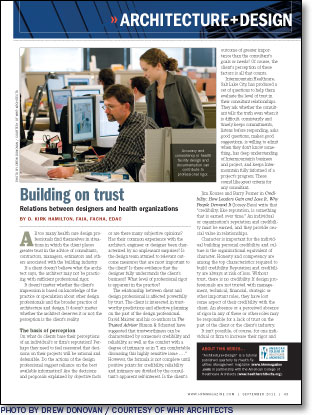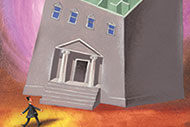 All too many health care design professionals find themselves in situations in which the client places greater trust in the advice of consultants, contractors, managers, estimators and others associated with the building industry.
All too many health care design professionals find themselves in situations in which the client places greater trust in the advice of consultants, contractors, managers, estimators and others associated with the building industry.
If a client doesn't believe what the architect says, the architect may not be practicing with sufficient professional rigor.
It doesn't matter whether the client's impression is based on knowledge of the practice or speculation about other design professionals and the broader practice of architecture and design. It doesn't matter whether the architect deserves it or not; the perception is the client's reality.
The basis of perception
On what do clients base their perceptions of an individual's or firm's reputation? Perhaps they need to feel reassured that decisions on their projects will be rational and defensible. Do the actions of the design professional suggest reliance on the best available information? Are the decisions and proposals explained by objective facts or are there many subjective opinions? Has their common experience with the architect, engineer or designer been characterized by no unpleasant surprises? Is the design team attuned to relevant outcome measures that are most important to the client? Is there evidence that the designer fully understands the client's business? What level of professional rigor is apparent in the practice?
The relationship between client and design professional is affected powerfully by trust. The client is interested in trustworthy predictions and effective planning on the part of the design professional. David Maister and his co-authors in The Trusted Advisor (Simon & Schuster) have suggested that trustworthiness can be characterized by someone's credibility and reliability, as well as the comfort with a degree of intimacy, as in "I am comfortable discussing this highly sensitive issue … ." However, the formula is not complete until positive points for credibility, reliability and intimacy are divided by the consultant's apparent self-interest. Is the client's outcome of greater importance than the consultant's goals or needs? Of course, the client's perception of these factors is all that counts.
Intermountain Healthcare, Salt Lake City, has produced a set of questions to help them evaluate the level of trust in their consultant relationships. They ask whether the consultant tells the truth even when it is difficult, consistently and timely keeps commitments, listens before responding, asks good questions, makes good suggestions, is willing to admit when they don't know something, has deep understanding of Intermountain's business and project, and keeps Intermountain fully informed of a project's progress. These sound like great criteria for any consultant.
Jim Kouzes and Barry Posner in Credibility: How Leaders Gain and Lose It, Why People Demand It (Jossey-Bass) write that "credibility, like reputation, is something that is earned over time." An individual or organization's reputation and credibility must be earned, and they provide crucial value in relationships.
Character is important for the individual building personal credibility, and culture is the organizational equivalent of character. Honesty and competency are among the top characteristics required to build credibility. Reputation and credibility are always at risk of loss. Without trust, there is no credibility. If design professionals are not trusted with management, technical, financial, strategic or other important roles, they have lost some aspect of their credibility with the client. An absence or a perceived absence of rigor in any of these or other roles may be responsible for a lack of trust on the part of the client or the client's industry.
It isn't possible, of course, for one individual or firm to increase their rigor and credibility so profoundly that the entire field is changed and design professionals abruptly gain respect. The advance of rigor must occur across the field over time, with many design practitioners and their firms improving their practices until the widespread client perception of design professionals has changed.
What is rigor?
The Merriam-Webster definition for "rigor" is strict precision or exactness. For "rigorous," it is manifesting rigor, scrupulously accurate and precise. Wikipedia suggests "Scholarship can be defined as intellectual rigor applied to the quality control of information, which implies an appropriate standard of accuracy, and skepticism applied to accepting anything on trust. It requires close attention to criteria for logical consistency, as well as to all relevant evidence and possible differences of interpretation." Wikipedia further suggests that intellectual rigor implies a single, high-standard application of uniform principles and consistency. The key terms are accuracy, precision, consistency, objectivity and reliability.
It is possible to distinguish scientific rigor in academia from professional rigor seen in practice. They seek different goals in the quest for different outcomes. Scientific or academic rigor requires consistency of appropriate research methodologies, precision in data gathering, objectivity in the analysis of findings and integrity in the reporting of results. Academic rigor is subjected to unbiased examination by independent reviewers to validate results. There are formal academic rituals in which information is not shared until peer-reviewed studies are published. The goal is advancement of knowledge or pure truth.
Intellectual or logical rigor may be seen in the actions of individuals as they interact with others. It is marked by scrupulously accurate language, precise descriptions of what is known, truthful admissions when something is not known, and cautious skepticism about new material as it is encountered. Evidence must be presented before new information can be cautiously taken as accurate. The goal is intellectual honesty, integrity and the development of credibility.
The ideal rigor for the design practitioner might be described as practical or professional rigor. This type of rigor requires the following:
- Consistency of design process methods;
- Precise and accurate fact gathering related to the client and its project;
- Design decisions based upon the best available information from research and practice;
- Automation of repetitive functions to reduce unexpected variation;
- Careful attention to compliance in the construction process;
- Scrupulous analysis of client outcomes and the completed building leading to thoughtful incorporation of feedback on subsequent projects.
A rigorous practice will enable architects to defend, justify and explain important design decisions because such a practice will be based more on objective decisions than subjective ones. Such a practice relies upon facts and empirical observations, enhancing the science of architecture while not ignoring the art of architecture. Such a practice will seek peer review in the form of independent reviews within the firm, among other team members, or from external peers. Rigorous analysis of the project's results will offer insights for future projects.
Advice for improvement
What should the design professional be doing to improve rigor in practice? What can be done to develop a practice that is consistently reliable with precise objectivity as it relates to important project decisions and crucial advice to clients? Here is some advice:
• Build strong relationships with clients based on truthfulness, honesty, integrity and open transparency.
• Form long-term partnerships with experts in estimating, scheduling, construction management and other areas in which clients are likely to seek advice. Bring the expertise to the table under the banner of the collaborative design practice.
• Strive for deliberate consistency in the use of language, definitions, measures and methods so each party means the same thing when something is discussed.
• Aggressively seek access to the best evidence from research and practice and use it to defend, justify and explain important design decisions. Always have as much or more credible information than anyone else in the room.
• Make more objective decisions and fewer subjective ones. Recognize and take advantage of decisions in which a subjective, aesthetic and purposeful decision is made, but be wary of subjective decisions that may be viewed as arbitrary. Try to envision how each decision might be viewed by the client and be prepared to justify those that may not be readily understood.
• Reduce unacceptable and unintended variation in designs. Make more decisions on the basis of recognized best practice and develop greater project consistency. Recognize when best practice is a responsible choice and when thoughtful innovation suggests an intentional variation.
• Document the design intent, both in the process and the product. Record the design hypotheses in the form of predicted outcomes, measures or behaviors that will be observed when the project is completed. Share them with the client, who can warn if they are off target and will be impressed if they produce good results.
• Improve the accuracy and precision of project documentation. Use standardization of materials and details to reduce unintended variation. Produce documents that are understood readily and followed easily by estimators, contractors and subcontractors.
• Automate repetitive functions, such as production of specifications or details.
• Ensure that construction administration produces accuracy in the building process and useful feedback from the field to the design phase.
• Measure the outcomes of every project with consistent methods to build a case for architectural performance and to improve predictions. Measure indicators that the client finds most important and measure items that will allow practice improvement.
• Make certain that there is an objective and independent assessment of past work with actionable feedback to future work.
• Share information with the client and with the profession. An architect's credibility will increase as the client observes the practice in real-life project situations. The credibility of the field increases as architects share useful information with their peers.
Much of this advice seems obvious. Much of it may be what some architects already are doing or for which they already are striving. Yet, it is not always easy to openly and honestly share a mistake with an important client.
Most often, honesty will serve better than deception, leading to greater trust. Few firms or designers routinely document design hypotheses and all too few architects or clients measure the outcomes associated with their projects. And few firms regularly subject their work to independent review.
Additionally, architects often labor under the delusion that they should not share their lessons learned with the profession, even though such behavior can boost the firm's credibility.
Evolution of design practice
Developing rigor, credibility and trust in a design practice can't be achieved through a quick fix. It is a permanent and ongoing commitment.
It is a journey toward a destination that is difficult to reach, but enormously rewarding once the health care design practice has arrived.
D. Kirk Hamilton, FAIA, FACHA, EDAC, is professor of architecture at Texas A&M University, College Station. He can be contacted via e-mail at khamilton@tamu.edu.
| Sidebar - Achieving best design practice |
| Health care architects and designers are familiar with the concept of "best practice" as a result of its use in medicine and nursing. The concept is widely used in many fields, including education, business, manufacturing and software development. While there is no single definition for best practice, it generally is based on careful collection and examination of relevant evidence, some action that results in a positive outcome, and the ability to reproduce such positive results in other situations. Best practice appears to have a clear affinity for evidence-based practice models. In medicine, there are clear models for grading the quality of evidence. There are such organizations as the Cochrane Collaboration (www.cochrane.org) that formally document the best evidence, and there is widespread usage of clinical pathways, guidelines, standards and decision-making rubrics to assist practitioners. If it were possible to identify design features that experienced experts could recommend by consensus, their inclusion in a design might be considered an example of best practice. For instance, there is consensus that both hand-washing sinks and alcohol gel dispensers be provided in each patient room to meet best practice standards. However, there is no consensus yet about locations, proximity to patients or the entry, line of sight, automated features, electronic monitoring and other key decisions associated with design for hand hygiene. In terms of professional liability, it is advantageous for an architect to be able to demonstrate practice at a standard rigorously evaluated by the profession, as in the case of specialty certification by documented experience, portfolio review, examination and compliance with continuing education requirements. This is the case for specialty certification as verified by the American College of Healthcare Architects (www.healtharchitects.org). It is the first specialty group to be organized, self-regulated and recognized annually by the American Institute of Architects. Such a group may well be able to extend the level of health care design best practice by supporting a review of important design concepts needing consensus. |
| Sidebar - Fostering trust by sharing info |
| It is all too common for design professionals to believe that what they have learned is proprietary and should be kept confidential. They suffer from the presumption that there will be competitive advantage if they refuse to share information. This is a behavior that exhibits a lack of trust in their competitors or the larger field and, in turn, means they will be seen as less trustworthy by others in practice or by potential clients. Practitioners who openly share their lessons learned are demonstrating confidence, trust and are advancing the profession. In many cases, the practitioner who openly speaks about or publishes important findings will be seen by the field and by prospective clients as someone practicing at the highest level. Instead of a competitive disadvantage, such sharing of information identifies a design professional as a leader in the field and an advanced practitioner. Transparent behavior seen as improving the health care design state-of-the-art is a powerful potential competitive advantage. What turns out to be equally, if not more, important is the need for such openness to include the lessons learned from situations the practitioner wishes not to repeat. This is where the real challenge lies. Many practices examine their projects to find success stories and rush to tout them with self-serving publicity. These promotional pieces are seen quickly for what they are — efforts founded entirely in self-interest. Too few design professionals exhibit the courage to tell the full story, warts and all. Those who honestly and rigorously share both the good and bad lessons, however, benefit from a major increase in credibility. Observers, including potential clients, see such open sharing as a sign of honesty and professional integrity, leading to much higher levels of trust. And trust is one of the primary criteria a potential client uses to evaluate a firm or a design professional. It may be counterintuitive, but health care design professionals should consider revealing their important negative lessons to be seen as trustworthy and high-quality practitioners. |





